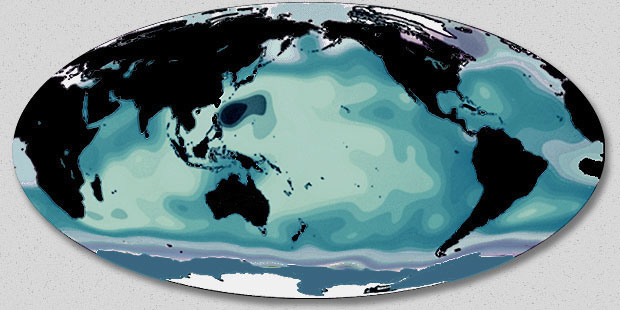
 |
| 1.2.1 |
 |
Earth's oceans cover a little over 70 percent of the surface of the planet. (NOAA image) |
| Oceans cover about 70% of planet Earth's surface. Many people refer to planet Earth as "the water planet" for this reason. Earth is at just the right distance from the sun so that water can be liquid at the surface. Planets closer to the sun have water mainly as vapor and planets farther away from the sun have water mainly as ice (solid water). Earth has all three forms of water - vapor, liquid, and solid (ice). Because of this Earth is a unique planet and the oceans are a unique (and extremely important) part of its makeup. |
 |
The four main oceans of Earth. (NASA image edited by GA) |
| The four main oceans on planet Earth are the Atlantic, the Pacific, the Indian, and the Arctic Ocean. Some people consider the southern portion of the Atlantic, Pacific, and Indian Oceans as another ocean they call the Antarctic (or Southern) Ocean but since there is no easily defined land mass surrounding the Antarctic Ocean it is usually not mentioned in geography. In the Antarctic lesson (in Bottom Dwellers) there is a discussion about this and various ways to refer to this unique marine area. The Atlantic Ocean is bounded by America on its western side and Europe/Africa on its eastern side. The part of the ocean north of the equator is often called the North Atlantic and the part south of the equator is called the South Atlantic. These distinctions are important as each of these has a distinctively different circulation pattern. The Pacific Ocean is bounded by Asia/Australia on its western side and America on its eastern side. The part of the ocean north of the equator is often called the North Pacific and the part south of the equator is called the South Pacific. These distinctions are important as each of these has a distinctively different circulation pattern just like the Atlantic Ocean. The Indian Ocean is bounded by Africa on its western side and Australia on its eastern side. Most of Indian Ocean is below the equator and thus in the southern hemisphere. |
 |
A south polar view of Earth shows how the Atlantic, Pacific and Indian Oceans mix near Antarctica. (Image is of a globe, made by Readers Digest, taken and edited by GA.) |
| The southern portions of Earth's oceans all flow together around the continent of Antarctica. |
 |
A north polar view of Earth shows the Arctic Ocean. (Image is of a globe, made by Readers Digest, taken and edited by GA.) |
| The Arctic Ocean is at the center of a north polar view of planet Earth. It is almost entirely surrounded by Canada, Alaska, Russia, Scandinavia, and Greenland. The North Pacific connects with the Arctic Ocean through the Bering Sea and Bering Strait - a rather small opening. The North Atlantic connects with the Arctic Ocean through the area between Greenland and Scandinavia - a rather large opening. This is why there are so many more icebergs in the North Atlantic as compared to the North Pacific. Most of the Arctic icebergs floating near the North Pacific become grounded before they get through the Bering Strait but in the North Atlantic many of these icebergs float into the the shipping lanes of the North Atlantic and may cause problems. The sinking of the Titanic was from such a large iceberg and since that catastrophic incident there has been a North Atlantic Ice Patrol with warnings to ships in the areas where there may be dangerous icebergs. There is no such thing (or need for it) in the North Pacific simply because of its geography. |
(Revised 1 July 2004) |